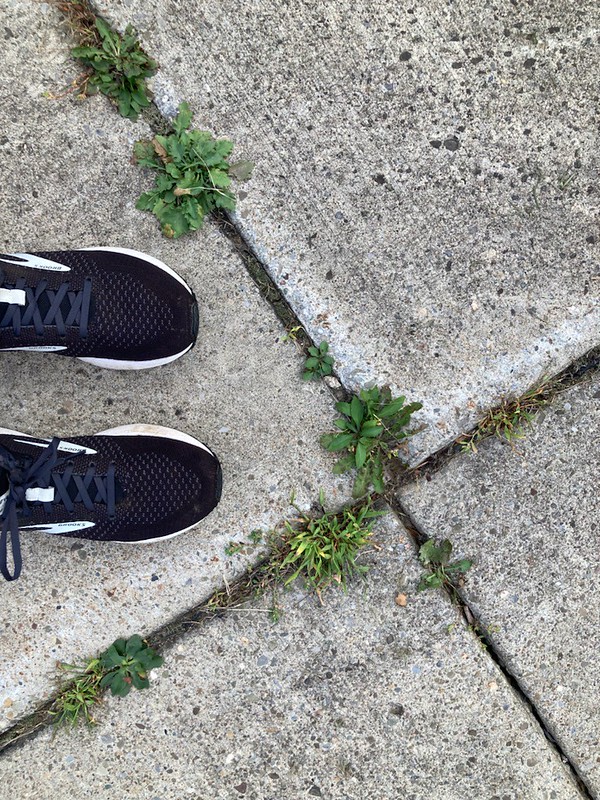When so much of the world went remote a year and a half ago, I attended a virtual conference on nature education. One session title was so intriguing I signed up for it not really knowing what it was about. It was called “Ruderals”.
I learned there, and in reading later, that ruderals are plants that grow in developed areas. Plants growing on what we may consider “wasted ground” such as abandoned lots or the edge of a crumbled driveway. They are the first to colonize a disturbed area, such as after a forest fire or flood. While a frequent word in the world of botanists and ecologists, it was new to me.
But the plants that this word describes are not unusual. They are some of the most common things we know, but may not notice. Dandelions growing in the gaps between sidewalks. Hoary Bittercress that can carpet newly raked garden soil with its petite leaves and white flowers. Plantain popping up in pavement cracks. Illustrating its ability to cultivate new areas quickly, plantain has been referred to as “white man’s footprint” because it appeared and thrived in areas where Europeans modified the ground for their purposes.

Ruderals are the weeds. Often the ones we don’t want. They are vilified for taking over, sometimes aggressively. They disobey and get unruly. The very word sounds like an unwanted thing. Inappropriate, but creeping its way in regardless.
In addition to being unruly and unwanted, we might also think of them as strong and tenacious, suited to growing where other plants just cannot. Their strategy is toughness.
The term ruderal was originally used by Berlin ecologists after World War II to refer to plants that spontaneously inhabited the ruins in the city. The word came from the Latin, rudus, meaning rubble. It would be hard for a long-lived tree like an oak to grow on rubble. But other plants can. Ruderals are the first responders that come and leave quickly but pave the way for other species to thrive.
Many ruderal plants have a short lifespan of one to two years. But their energy is devoted to seed production. For seeds are what can travel to colonize new areas. For example, one plantain plant can produce up to 20,000 seeds. A dandelion has 150 – 200 seeds on just one flower head. And those seeds can travel on the wind for a mile or more. When ripe, Hoary Bittercress seed pods explode, rocketing their next generation 16 feet. Once landed, the seeds can often stay in the seedbed for years, waiting for the right time to grow.
Also, if given the chance, they lay the foundation for other species. Perhaps not in a sidewalk crack, where they are apt to be rip out. But in an environment where humans have less control and nature has more — a forest, a stream bank, a wild field — ruderals play an important role in renewal of that habitat. Their roots work to break up hard soil while preventing erosion. Their death and decay provide nutrients for the next generation.
This is succession. Years ago, I worked at a residential outdoor education school, which introduced big topics with skits. One of my favorite was the Succession Race, which we did prior to a forest lesson. One person would dress as grass, another a birch, another a hemlock. The scene was a race track. The characters would race around until there was a winner. In the skit, the grass would start first, take up all the sunlight and grow fast. Soon after the birch tree would start, a little slower but steady. The birch would soon lap the grass, shading it, and the grass would fall out of the race. Then the hemlock would quietly start, under the shade of the birch, but slowly. At times, they would even race together. Eventually, the hemlock would lap the birch and the birch would fall out of the race.
Succession is the process of change in an environment over time. When there is a disturbance, some plants come in first. They thrive in sun and poor soil. These are the ruderals. They pave the way for the longer-lived plants, such as the birch and hemlock. And when those die, the race begins again.
At times dealing with tough and hardy plants that want to take over feels like taming the wilderness. Keeping the weeds out of our gardens. Maintaining hard surfaces we lay down so they doesn’t get overrun. Making sense of a complex habitat like a forest. Many ruderals are also non-native, invasive species that cause more harm than good to the environment. Nature is complicated.
So perhaps dealing with plants is more like setting boundaries. After all, appropriate boundaries are important in any healthy relationship. And humans and nature certainly have a complex relationship. But one we want to be healthy.
I also relish when nature takes over or comes back. When a seemingly delicate plant root cracks through a hard surface. When something grows where nothing was before. It reminds me that nature is strong. In the most basic way, ruderals are a symbol of hope that nature can persevere — and even beat us, despite our best efforts to keep it out. I still don’t want too many weeds in my garden and clear my sidewalk edges of grass. And sometimes change is hard to live through. But I appreciate the tenacity, the resilience and the ongoing transformation that is a ruderal.
Audubon Community Nature Center builds and nurtures connections between people and nature. ACNC is located just east of Route 62 between Warren and Jamestown. The trails are open from dawn to dusk as is Liberty, the Bald Eagle. The Nature Center is open from 10 a.m. until 4:30 p.m. daily except Sunday when it opens at 1 p.m. More information can be found online at auduboncnc.org or by calling (716) 569-2345.
Katie Finch is an educator at ACNC.


Recent Comments